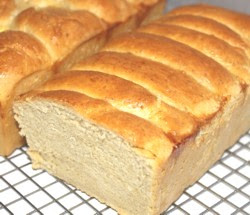Friday, April 8, 2011
Brioche Bread
This recipe comes from a cookbook for French breads. The author was lucky enough to trek all around France and persuaded chefs to part with their bread recipes. Then he came back to the states and converted the recipes for home bakers.
This recipe comes from Le Havre, a port city that is close to Normandy. There are several bakeries in that town with windows full of braided loaves filled with raisins or cheese. The loaves, called brioche, are a favorite among the townspeople.
Since I have not made this bread before, I opted to make it without any filling. The loaves turned out great, crusty on the edges and a buttery soft interior. The bread looks to be very dense, but is not heavy at all. I have had my share of dense bread and it usually starts with whole wheat flour.
This bread does take a lot of time due to numerous sessions of rising. The active part of the recipe is not difficult, so if you are around the house all day (for whatever reason) consider making it. You will be glad you did. Start 1 day before you want to serve the bread. The second day is just for another rising time and baking. This recipe makes 2 loaves.
Brioche Loaves
adapted from The Breads of France cookbook
Ingredients
1 cup warm water (105 to 115 degrees)
5 eggs (room temp)
3/4 lb butter or 3 sticks (room temp and cut into small chunks)
2 packages or 4 1/2 tsp of regular yeast
1/3 cup non fat dry milk
1 tbs sugar
2 tsp of salt
5 cups flour and more for dusting when kneading
1 tbs milk (for top glaze)
1 egg (for top glaze)
In a large bowl, sift together only 2 cups of the flour and all the salt. Then whisk in yeast, sugar and dry milk. With a wooden spoon, form a well in the middle of the flour mixture big enough to hold one cup in the center. Then pour in the warm water. Fold the flour mixture inside the bowl into the pool of water in the center, making a dough.
Add each egg into the batter one by one, stirring to with each addition to distribute throughout the batter. Drop the chunks of butter into the mixture. The butter should be blended to the point that only small chunks of butter exist in the dough.
The additional amount of flour (3 cups) can now be added in one cup increments. You can use a spoon or your hands to make sure all the flour is incorporated into the dough.
Turn dough onto floured surface and set the timer for 7 minutes. The dough will be sticky and soft. Knead for a few minutes with your hands, adding flour when needed. Then take a small break by forcefully dropping the dough on the work surface. Continue with this process until the timer goes off.
Shape the dough into a ball and place it in a well oiled bowl. Cover with plastic wrap and let rise undisturbed for 1 1/2 to 2 hours. The rise should be at room temp (70-75 degrees).
After the first rising, the dough should be double in volume. Take off the plastic wrap and punch down dough. Roll the ball of dough upside down and place back in bowl. Cover and let rise again for 1 hour. The dough will need to be punched down, rolled and covered once the 2nd rising is complete.
Take the bowl of dough and place in fridge overnight or at least 6 hours. Once the chilling time is complete, prepare your pans by greasing the inside. Divide the dough into 16 equal pieces. Roll 8 pieces into balls and the other 8 pieces into cylinders or logs to fit the width of the pan. Place the 8 balls in one pan, alternating them from left to right in the 4 1/2 inch width, going down the length of the pan. In the other pan, lay the logs with each small end touching the left and right of the 4 1/2 inch width going down the length of the pan.
Cover each pan with wax paper and set aside to rise for 2 1/2 to 3 hours. 20 minutes prior to completion of rising time, preheat oven to 380 degrees.
Take a small bowl and beat together the top glaze ingredients. After the last rise noted above, uncover the loaves and brush the glaze on top. Covering all top areas, including corners. Place each loaf in oven on middle rack and set timer at 18 minutes for loaves to bake. Once timer goes off, rotate pans and bake for an additional 17 minutes. Bread is done baking when it has a golden color and sounds hollow when tapped on the bottom.
Remove pans from the oven and run a knife around the edges. Then release loaves from pan and turn upright on rack to cool. Handle carefully, because the places where the dough joins is fragile. Should you want a more toasty loaf, place back in oven (without pan) for 5 to 8 minutes.
Then enjoy a taste of France in your own kitchen!

